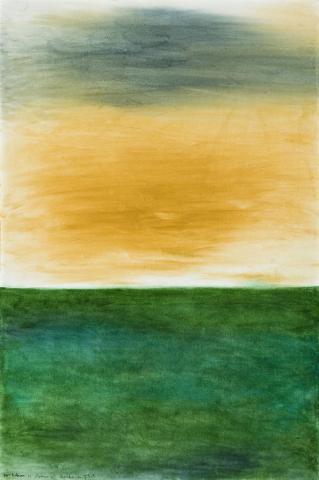A POEM OF KAIPARA FLAT, 1971
Colin McCahon
synthetic polymer paint and pastel on paper
102.0 x 69.0 cm
signed, dated and titled lower left: McCahon ‘71 Poem of Kaipara Flat
Gow Langsford Gallery, Auckland
Private collection, Sydney
In January 1971 Colin McCahon resigned his teaching position at the University of Auckland School of Fine Arts (Elam) to become a full-time painter. Although he would still teach at a summer school in Kurow, North Otago, for several years thereafter, he was now free to dedicate his time solely to painting at the Muriwai studio he had acquired 18 months earlier. Located on a hill inland of Muriwai Beach township, some 40 minutes drive north-west of Auckland, the studio was two kilometers in a straight line to the closest point on the beach, although double the distance by road.
Of his new surroundings, McCahon wrote:
'From my studio at the south end of Muriwai Beach, the beach and sand bar that fronts the Tasman Sea extends 48 miles to the Kaipara Harbour mouth. This is the sand dune and lake area of Waioneke. Kaipara Flats are north of Helensville. This is a shockingly beautiful area - I do not recommend any of this landscape as a tourist resort. It is wild and beautiful; empty and utterly beautiful. This is, after all, the coast the Maori souls pass over on their way from life to death - to Spirits Bay 'carrying their fronds and branches' The light and sunsets here are appropriately magnificent.'1
Following the completion of the monumental Gate III, 1970 (Victoria University Collection, Wellington), McCahon's attention turned to subjects inspired by his exploration of his Muriwai studio's immediate environs.
In a series of exuberant 'Turnersesque' watercolours and acrylics on paper, McCahon both acknowledged his surroundings and reflected his concerns over the environmental issues he felt threatened them. In striking contrast to the palette of black, white, sepia and shades of grey that characterise the three monumental paintings that pre-occupied McCahon in 1969-1970 (Practical Religion, Victory over Death and Gate III), throughout the various series that followed - View from the top of the cliff, Ahipara, Helensville, Muriwai and A Poem of Kaipara Flat - McCahon used colour to create mood and atmosphere.
'All the colour & fun is a direct result of leaving school', McCahon wrote in a letter to his friend Maureen Hitchings in May 1971.2
In A Poem for Kaipara Flat, 1971, McCahon depicts a view across the flats and marshes of the lower reaches of Kaipara Harbour towards the western horizon, where lingers the vestiges of one of his 'appropriately magnificent' sunsets. Most likely originally exhibited with other works from the series in the artist's July 1971 exhibition at Dawson's Gallery in Dunedin, A Poem for Kaipara Flat is a visual sonnet to a landscape McCahon loved.
1. Colin McCahon, Statement for Days and Nights, Helensville, Dawson's Limited Exhibition Gallery, Dunedin, July 1971
2. Colin McCahon quoted in Brown, G., Colin McCahon: Artist, Reed Books, Auckland, revised second edition, 1993, p. 109
WE ARE GRATEFUL TO MARTIN BROWNE FOR PROVIDING THIS CATALOGUE ENTRY
